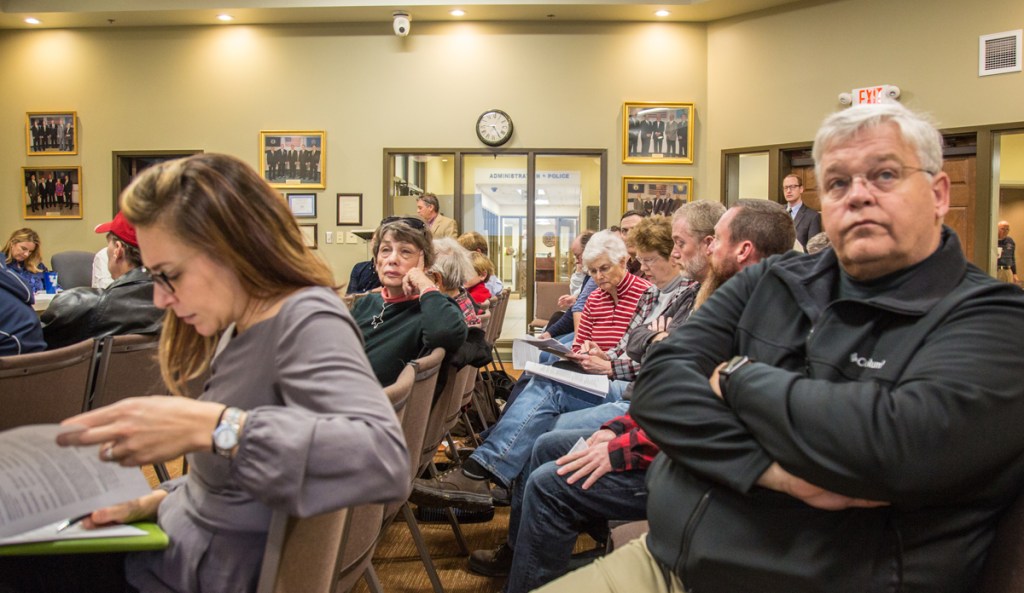P&Z OKs zone change for proposed distillery in Danville
Published 8:45 am Thursday, December 7, 2017

- Around 40 people packed the public meeting room at Danville City hall Wednesday morning for a three-hour P&Z meeting. They attended to observe and comment on a proposed zone change that would allow a distillery project to move forward.
A zone change has been recommended for approval that would allow a new distillery project in Danville to move forward.
Concerns were raised at a public hearing Wednesday about traffic and safety on Lebanon Road where the distillery would be located, and some neighbors questioned if the distillery’s presence would lead to mold concerns in the area. But ultimately, the Danville-Boyle County Planning and Zoning Commission voted unanimously in favor of recommending the zone change for an approximately 142-acre piece of property owned by the Boyle County Industrial Foundation.
The Danville City Commission must still approve first and second readings of the zone change before it’s official. And the P&Z commission placed three conditions on its approval, all of which focused on preventing traffic problems on Lebanon Road:
Trending
• any entrance off of Lebanon Road will be subject to approval and directed by the Kentucky Department of Transportation;
• all truck traffic, excluding construction traffic, must not use the Lebanon Road entrance to property, but a connector road from Wilderness Trail Distillery or a future road planned to be built off of Corporate Drive in the industrial park; and
• when the second, larger phase of the project is built, the truck traffic must flow on the yet-to-be-built Corporate Drive connector.
The zone change
The Industrial Foundation wants to change the zoning for the property from agricultural to industrial, in order to accommodate plans from the yet-to-be-named prospective developer of the distillery.
The property is adjacent to Wilderness Trail Distillery and the Boyle County Industrial Park, but actually sits just outside a pair notable boundaries, P&Z Director Steve Hunter told P&Z commissioners during Wednesday’s public hearing.
Trending
Despite being owned by the Industrial Foundation and bordering the industrial park land, Boyle County’s future land use map — which is supposed to dictate how land should be zoned — calls for the land to remain classified in an agricultural zone, Hunter said.
The property also falls partly outside the future land use map’s “urban service boundary,” which is theoretically the boundary beyond which Boyle County does not wish development to occur, Hunter explained.
In addition, the land was not previously qualified to receive city utility services from Danville, including sewer and water. But the city recently annexed the land and approved an agreement concerning utilities in order to allow the economic development project to move forward.
Hunter said state law has “very clear guidance” on how zone changes can be approved. If a zone change is not in compliance with a P&Z’s comprehensive plan — of which the future land use map is a part — then there are two exceptions that allow the zone change anyway:
• inappropriate zoning — when a mistake was made on a map, for example; or
• major changes — when, according to state law, “there have been major changes of an economic, physical or social nature within the area involved which were not anticipated in the adopted comprehensive plan.”
In filing its zone-change application, the Industrial Foundation stated it would try to use the second exception for “major changes” and included a narrative written by Economic Development Partnership CEO and President Jody Lassiter, arguing that case.
“… a major change has occurred in the Commonwealth of Kentucky with expansion and growth of the bourbon distilling industry,” Lassiter wrote. When Boyle County adopted its comprehensive plan and future land use map, it “was not targeted as a location for bourbon distilleries.”
“The (comprehensive plan) does not anticipate the unique needs of distillery location and development; namely, a distillery prospect often targets farmland or traditional agriculture tracts that may also include historic structures as an iconic representation of their product,” Lassiter wrote. “In Boyle County, such a location must be in close proximity to the city limits of Danville, Junction City or Perryville to allow alcohol sales due to the fact that the unincorporated areas of Boyle County remain a dry option territory in which alcohol sales are not legalized. Therefore, optimal locations for distilleries in Boyle County are now on the perimeter of the three cities that have legalized alcohol sales. The comprehensive plan and (future land use map) do not accommodate these factors, nor the unbridled growth of the bourbon industry within Boyle County.”
But the “major changes” argument may not have even been needed. Hunter noted numerous points in the text of the comprehensive plan where goals and priorities stood in contradiction to the idea that the land in question should remain agricultural.
“That’s why you guys are the planning commission and I’m just fortunate that I don’t have to vote,” Hunter said.
Winfield Frankel, an attorney representing the Industrial Foundation, said his client believes the zone change is in compliance with the comprehensive plan.
The distillery project is a “natural” or “organic” extension of the industrial park land, which meets the comprehensive plan’s goal of industrial development occurring in the industrial park or adjacent to it, Frankel said.
“We believe that we’re in compliance with the comprehensive plan and that the other findings aren’t really necessary, however we’re ready to address those — namely the major economic changes in the area,” he said.
Frankel cited statistics about the current “bourbon boom” in Kentucky, including bourbon’s contribution to the state economy has risen from $3 billion to $8.5 billion since 2008; and the value of bourbon barrels being held in Kentucky has gone up 135 percent over 10 years.
“This is not just an arbitrary request that we have where we’re saying, ‘well we’d like for a bourbon distillery to come or bourbon rickhouses to come;’ we’ve actually got one on the line,” he said. “We just want to make sure that Danville doesn’t miss this opportunity.”
Asked later in the meeting why the Industrial Foundation hadn’t previously asked for its land to be zoned industrial, Frankel built on Lassiter’s explanation of the bourbon boom changing things substantially.
“Before this project came across the Industrial Foundation’s desk, there hasn’t been a lot of expressed interest (in this land). … We never really saw the need to have this piece of land change,” he said. “But now that we’ve got this entity that wants to use it, we want to change it because we’ve got a fish on the line.”
“We never really anticipated that this type of industry would want to locate in Boyle County, so it remained agricultural,” Industrial Foundation Chair John Albright affirmed.
Background
The Industrial Foundation included a conceptual map of the distillery grounds with its zone-change application, which shows a “presentation center and office” with parking spaces at the entrance off of Lebanon Road. Behind that, there would be a “distillery” with its own parking lot and 17 “rickhouses,” warehouses that are used to store barrels of alcoholic drinks as they age. The map also notes an “access road to Wilderness Trail Distillery” as part of the plan.
Hunter said Wednesday the plan is expected to occur in two phases: The first phase would involve building the presentation center and three rickhouses on the front portion of the property; the second phase would be a much larger project to construct the distillery building and the other 14 rickhouses.
Lassiter said the second phase may never even happen — it depends on how things go with the first phase.
Frankel said initially, the project is expected to create five to 10 “career-oriented jobs.”
“Depending on how much expansion actually occurs on the back end of the property, it’s really hard to pinpoint how many new jobs are going to be created,” he said. “… It could be 50, it just depends.”
Lassiter said bourbon businesses often have “low job intensity” but “high capital intensity.”
“Three rickhouses containing 22,500 barrels apiece are projected in the first phase,” he said. “As those little barrels of bourbon are sleeping, they generate a huge amount of property taxes.”
About 75 percent of those new property taxes will go to the Boyle County School District, Lassiter said.
“This is going to be a significant impact for property taxes,” he said.
Lassiter said the local agriculture community is “welcoming” the project as well, because distilleries drive up demand for grain, meaning farmers can make more from their land.
The Industrial Foundation’s agreement with the City of Danville states that water service can be extended to the property immediately, but sewer service will follow as much as five years later.
New P&Z Commissioner Jim Boyd asked about that aspect of the agreement and what would be done during the first five years without sewer access.
Kendal Wise, an engineer with Vantage Engineering who is working on the project, said the first phase is largely focused on the three rickhouses, which won’t require sewer. If the need for a sewer system did arise sooner, sewer could be extended sooner, he said.
“The need for sewer isn’t huge, at least until the distillery goes in,” he said.
For and against
Three people rose to speak in favor of the project during the public hearing: Jennifer Kirchner, executive director of the Danville-Boyle County Convention and Visitors Bureau; Rob Caldwell, a neighbor who lives adjacent to the proposed distillery property; and Mike Perros, mayor of Danville.
“I struggle with development sometimes, too, and giving up green space,” Kirchner said. “… (But) this is a really sustainable and smart use of this land.”
“I think the best use for this land would be an arboretum with about four miles of multi-use paths,” Caldwell said. “If that isn’t going to happen, I think the next best bet is what they have proposed … one of the things that I enjoy as I ride around Kentucky is seeing the old tobacco barns … these rickhouses are kind of the new tobacco barn in Kentucky.”
“I strongly feel that we are on the cusp of a real opportunity here,” Perros said. “I think we have the opportunity here to see further development in what I consider to be a very, very, very clean industry. Imagine, if you will, that Danville becomes a destination for bourbon tourism second only to Bardstown. That may sound like a leap to you, but it’s not.”
Three people spoke against the zone change: Kevin Faulkner and Charlene and Michael Maddox. A fourth member of the public rose later in the meeting to state her concern that there wouldn’t be enough access roads for fire trucks if a fire were to occur.
Faulkner said rezoning would increase the risk of accidents on Lebanon Road; add light and noise pollution; and, most importantly, create a problem with a type of mold he called “whiskey fungus.”
There have been lawsuits in other areas over mold problems created in communities by the presence of distillery rickhouses, he said.
“I believe it definitely will not make Boyle County a better place to live for myself or for the 20 or so families and neighbors that live near me along Lebanon Road,” he said. “… It could be that it’s a good thing; it definitely doesn’t seem for us as residents, who, when we moved there, it wasn’t zoned that way.”
Charlene and Michael Maddox echoed Faulkner’s concerns about mold and traffic safety.
“There’s a lot of things we do agree with; we’re not totally opposed to it,” Charlene Maddox said. “But we do think it needs a little bit more research in the areas of those safety concerns, economic and health issues.”
Shane Baker, co-owner of Wilderness Trail Distillery, responded to the concerns about mold. He said in areas where lawsuits have been filed, distilleries built rickhouses in “non-wind-dispersed areas,” and built them much too close together. Wilderness Trail selected its location on Lebanon Road because of the winds that constantly blow, and it follows the modern requirements that rickhouses stand at least 200 feet away from any other structures.
“The mold or fungi — it is ubiquitous to our environment. It is everywhere in the world,” Baker said. “Distilleries do not cause it; distilleries do not produce it; they do not provide it to the environment. What happens is in the presence of certain volatile compounds, that yeast or any organism can perpetuate.”
Sight lines
The biggest sticking point for members of the P&Z Commission was safety along Lebanon Road. Commissioners questioned the wisdom of putting an entrance along that stretch of road, which is narrow, curved, near a hill and already known for being a wreck-prone stretch of highway.
Wise, the engineer, said he and a surveyor checked the roadway and found that sight lines from the proposed entrance in either direction meet or exceed the state requirement of 495 feet. The nearby entrance to Wilderness Trail Distillery and the intersection of Lebanon Road and Alum Springs Cross Pike both have worse sight lines, Wise said.
Baker said traffic was a concern on Lebanon Road before this distillery project arrived. Wilderness Trail has attempted to do what it can by adding two developed roads leading into its location.
Baker said the first phase of the proposed project may take four or five years to complete, and there would be almost zero traffic impact during that time.
“We wouldn’t perceive any increased traffic at all compared to the current traffic,” he said. “… It will take … three years or four years to basically fill those warehouses. All of that traffic would be through the interchange with our distillery, so we would basically be filling those warehouses. So there would be no immediate traffic on Lebanon Road.”
Doubts remained about the safety of adding the Lebanon Road access point throughout the meeting, however.
“I’m still not comfortable with the access point, personally,” P&Z Director Hunter told commissioners later in the meeting.
Hunter said he drove out to the area to see for himself what it’s like and even pulled into a gravel drive on the property in question and then turned back onto Lebanon Road.
“It’s sketchy out there — that’s the best I can say,” he said.
Hunter said the Industrial Foundation has agreed to add a right-hand turn lane for deceleration when approaching the distillery from Danville, but there isn’t an easy solution available for traffic coming from the west.
“At this point, the state does not have that road-widening on their six-year plan,” he said, explaining that widening of the road is likely a long ways off.
Hunter suggested a traffic study could provide some answers, but it would cost money. In other areas, P&Z agencies often require developers to submit traffic studies that show exactly what the impacts will be and what is needed to handle the changes.
“The unknowns are still a bother to me, but the good news is this: We get to see a site plan down the road if this is approved,” he said.

P&Z Commissioner Jeffrey Baird, left, questions whether truck traffic to the proposed distillery could be routed through a different entrance than the one planned for Lebanon Road.

Attorney Winfield Frankel, left, and EDP President Jody Lassiter address concerns from P&Z Commission members about plans for the new distillery project.






